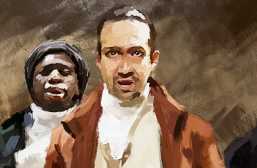The Applied Author: From Concept To Completion
A timely matter of discord in writing courses is, by preponderance of evidence, revealing the ideal method for conflagrance of words worthy of perusal by the readership at large. By a long list of leading educators, in hindsight, the virtues of several indispensable devices are henceforth extolled. This segment identifies the source and function of each implement relied upon by practitioners of literature, listing the most common ones, you are hereby commissioned to discover the rest.

First and foremost, the novice and seasoned writer have no doubt been formally exposed to or have adequately applied the standard outline along the path from creativity phase to drafting phase to revision phase, adroitly toward the final refinement stage of the writing process. At the very least, the outline provides a starting point, a midsection (or two or three or more), and closure. The outline contains several, if not, orders upon layers of discarded or probable clusters of notation for consideration, contemplation, or contrivance. As the proverbial square one that the outline ought to represent, it is the home base, the dirigible for the stormy voyage that awaits every author. Without it, all editing complications will inevitably exacerbate the deadline, causing even minor setbacks to appear insurmountable; in the strictest sense, incomprehensible. The peerage would concur, any counterpart to literature recognizes it as none other than the checklist; in pilot nomenclature, in business protocol, countless other professions.
Any point in the drafting process can benefit from variations, whether indirect or formal, of outlining. Most professional writers can perform all the necessary portions of drafting, admittedly, within the confines of their mind. Nonetheless, it goes without saying that even the writer that adheres to his own talents, can often be swayed by the need to make annotations, on paper, with pen, by keyboard. Their willingness and devotion to do so is only overshadowed by those who bypass that procedure with the modern writing tablet—the word processor; only to be outdone by the writer who carves his craft with a myriad of Post-It paper. The question remains, once having committed to usage of the outline, of where to find the words, the meaning, the correlations, and the categories of expression that govern language as pretense to conventional communication.
Begin by securing a reputable version of any standard dictionary and an exhaustive brand of thesaurus. As a reference, each text alone serves to enrich the context thereby making light of seemingly obscure concepts, in the process; endearing the writer and the reader, alike. Both texts work in unison to blossom the literary impulse; in concert with an outline, the artistic end product truly and vibrantly blooms. By employing them, as a starting point, as a propellant of thought, you stand to lose nothing—to gain everything.
With such reference books tucked away and thoughts hastily inscribed on paper or forged on screen, the reticent scribe would no doubt feel justifiably liberated. Except that, manuscripts are likely to undergo a series of disappointing rejections and stand to be debunked for one reason or the other. The writing phase is the primary portion of a highly intricate endeavor. It precedes the proofreading stage which verifies the effort started in the earlier phases of composition and, as shown further on, the creativity phase that engenders it all.
In this manner, common writing methods will be delineated for further refinement of drafts. Notably, the demarcation of principle approaches to proofreading as the prime objective for improving the narrative effect of the essay.
Most writing effort is devoted succinctly to the penning and subsequent submittal of the assignment. Period. Ask one student to revamp a draft for clarity or organization and you may notice apprehension or disdain. Ask another student the same activity and you may be handed a masterpiece in the making.
In the latter, the draft is ripe for encouragement, effusing lines of reasoning that stand ready to be commanded into territory unknown. In the former, the draft has reached a plateau whose only release has been inexplicably eclipsed. In this instance, diffusion by the instructor is perhaps the only outlet for the student. Assuming the impasse is the result of misguided inquiry, the best recourse could be to formulate new questions that spawn from the reading, the problem, or any relevant digression of topic.
In the second instance, the writer has committed to a vision, harnessed the workmanship, and now openly gives the content its due diligence by exposing it to the scrutiny of the audience. The audience thereby points out lapse of judgment, expressive flaw, narrow reasoning, so on, so forth. Ideally, the writer competently redresses the intention and consequently realigns the substance beneath the narrative. This cycle of proving the thesis is limited only by the will and wont of the course constituent.
It behooves each type of writer, therefore, to perform perfunctory levels of proofing in order to make progress or to see the matter through to the end. Take the draft assignment and read many times over for fluency, error, substance, voice: at slower pace, by whisper, or in bellow. When the draft is read by another person, it provides an insight into discrepancies not immediately apparent to the author, in all facets of grammar. A draft that has stifled from lack of textual momentum can more than likely benefit from complementary sources that reverberate by providing a more thorough examination of the topic—in a depth of field that cannot be ascertained solely from the classroom textbook. To that end, reward being proportional to the amount of force exerted, duly applies, as it does among other disciplines that abound.

So, by this point, the writer has acquired the prime materials to set forth the quintessential literary masterpiece, garnered the advice of the proofreader alluded to above, and begins to contemplate the light of at the end of the tunnel. Except, what often besets is the notion that a matter rising with the best of intention has quickly splattered into a behemoth of a chore. In order to tame the heap into manageable morsels of accomplishment, this portion of the segment will layout the elements of inertia behind elaboration of superlative verse, through a basic question followed by more classic examples.
Select from the list of options below, the concept that defines a crucial requirement for pristine craftsmanship of essay fluency.
- a theme
- a transitional phrase
- a context
In all fairness, a question directed at three different people will inevitably yield three different outcomes. As such, all three options (or any permutation thereof) are equally viable answers to the question as presented. The question points to a larger issue that looms over each writer. A writer that is at ease with a thematic approach will, undoubtedly, pick the first option as the correct choice. A writer with a penchant for transition will manifest his argument with words befitting, marking the second option without hesitation. A writer who is versed in history, science, or art will remain true to his nature and begin to weave reams over reams of verbosity at people, places, and periods–confidently casting his vote for the last option.
The theme is a standard by which the author delineates his argument, honing the statements toward the point under consideration. It is usually revealed early in the draft, occasionally prods at the reader throughout the body of the text and, by the point of closure, is well-defined and encourages the reader to seek out prevalent viewpoints standing idle with agility. Assuming the writer has exceeded the objective, the theme then persists and permeates.
The transitional phrase is the stream that induces thought by keeping prior remarks within sight and hinting at their relevance into forthright directions. All elementary squabbles aside, the writer definitively has his lot to fill. What would be the grounds for acclamation or provocativeness of novel were it not for the context–one might ponder–The Grapes of Wrath by John Steinbeck without a Great Depression; A Tale of Two Cities by Charles Dickens without a revolution; War and Peace by Leo Tolstoy without an aristocracy; remove the ambiance, and you thwart the longing to conceive the narrative, no matter how formidable your inventory of utterance. William Shakespeare in, As You Like It, understood this all too well.
[Jaques to Duke Senior]
All the world’s a stage,
And all the men and women merely players;
They have their exits and their entrances,
And one man in his time plays many parts,Turning again toward childish treble, pipes
And whistles in his sound. Last scene of all,
That ends this strange eventful history,
Is second childishness and mere oblivion,
Sans teeth, sans eyes, sans taste, sans everything.
From a pragmatic point of view, this clearly exemplifies basic writing elements that nudge at the writer, novice or expert, at every stage of composition. When deciding what to write, consider the following: the historical framework, the nature of being, the sciences, the arts, all equally viable pursuits worth penning. Irrefutably still, the feeble assemblage of evidence to support the monologue is a labor of love, so to speak. In figuring the progression of one idea over the next, the writer learns to capture the audience through his unique mode of expression, seamlessly etching insights or sowing seeds into the mind and soul of the reader. It is inevitable for subtle nuances to be subsumed along the way to the final journal entry. Nonetheless, the literary enthusiast knows that the best manuscripts speak volumes–beneath a vocal stream and beyond the limit of thought.

In consideration of all the standard methods for writing an essay, master or apprentice notwithstanding; the incumbent writer will inevitably reconsider the general procedure for the assembly of words into a cohesive composition. In that regard, this portion aims to describe in detail, the process behind each layer of drafting a typical essay assignment given the prior notions.
The writing topic usually presupposes the ideas that will support the essay. An essay assignment that focuses on a plausible relationship between major American industrialists, for instance, could start with the three points listed below. Each industrialist appears in chronological order by significance of invention.
- John D. Rockefeller
- Henry Ford
- Bill Gates
The previous section suggests an initial order of precedence for the thoughts presented in the essay. This is commonly expressed using transitional phrases or key terms similar to those provided in the next section.
By starting the first and largest oil company in history, John Rockefeller …
Without Henry Ford applying the possibilities provided by petroleum-based products …
… innovative technology leaders such as Bill Gates are continually contributing …
After the main ideas have been established and the flow of thought planned, each individual paragraph can be formulated through leading and trailing statements. Those statements can be unique to that particular theme, but can also allude to prevailing themes.
Before the discovery of petroleum in the United States, life for the common person was quite different and tedious. By starting the first and largest oil company in history, JOHN D. ROCKEFELLER paved the way for illumination and heating of homes where meals could be prepared with oil stoves rather than depending on other sources, an impulse that promoted self-sufficiency. Aside from making living quarters more hospitable, the Rockefeller Standard Oil Company greatly enhanced the creation of engine part lubrication and combustible fuel to power motion which led to transportation methods beyond horse and carriage.
Without HENRY FORD applying the possibilities provided by petroleum based products, people would not have the option today to travel by automobile, train, airplane, or boat. Indeed, the invention of the engine that is lubricated by oil as well as powered by gasoline, has undoubtedly changed the way people travel, entertain, and earn a living. This has been the contribution of Henry Ford and his Model T vehicle along with the assembly line method of mass production.
It is not out of the ordinary to wonder at what point innovation starts to subside. In terms of the automobile industry, the answer is that it will likely keep surprising the consumer. This is evident in the computer industry with the advent of the computer laptop model. Most modern automobiles are equipped with computer chip technology to support vehicle operation such as Anti-Lock Braking or Autonomous Emergency Braking feature plus storage of data to aid in diagnosing mechanical failure. In certain segments of the market, the device being used to perform the repair often uses software that is Windows compatible. This is a prime example of how innovative technology leaders like BILL GATES are continually contributing to consumer convenience in daily life within their industry but also in tandem with complementary industries.
The paragraph samples presented in the section above require just an introduction paragraph and a conclusion paragraph to be considered complete. Since the topic is historical in nature, one way to introduce the essay is by defining the points of reference represented by the initial criteria of three pivotal industrialists. Thus, Rockefeller began his work about 1870, Ford started production around 1903, and Gates entered the computer market on 1975. Likewise, a pertinent discussion for the conclusion could be the implication of future innovations, such as solar energy or alternative fuel. The entire essay, all components combined, is re-conceptualized as follows.
An idea can be generated in a blink of an eye. An industry, on the contrary, can take nearly a century, if not longer, to turn into reality. In the transportation industry, that invention formed near 1870, gained momentum in 1903, and finally reached another milestone on 1975.
Before the discovery of petroleum in the United States, life for the common person was quite different and tedious. By starting the first and largest oil company in history, John D. Rockefeller paved the way for illumination and heating of homes where meals could be prepared with oil stoves rather than depending on other sources, an impulse that promoted self-sufficiency. Aside from making living quarters more hospitable, the Rockefeller Standard Oil Company greatly enhanced the creation of engine part lubrication and combustible fuel to power motion which led to transportation methods beyond horse and carriage.
Without Henry Ford applying the possibilities provided by petroleum lubrication and combustible fuel, people would not have the option today to travel by automobile, train, airplane, or boat. Indeed, the invention of the engine that is lubricated by oil as well as powered by gasoline, has undoubtedly changed the way people travel, entertain, and earn a living. This has been the contribution of Henry Ford and his Model T vehicle along with the assembly line method of mass production.
It is not out of the ordinary to wonder at what point innovation starts to subside. In terms of the automobile industry, the answer is that it will likely keep surprising consumers. This is evident in the computer industry with the advent of the computer laptop model. Most modern automobiles are equipped with computer chip technology to support vehicle operation such as Anti-Lock Braking or Autonomous Emergency Braking feature plus storage of data to aid in diagnosing mechanical failure. In certain segments of the market, the device being used to perform the repair often uses software that is Windows compatible. This is a prime example of how innovative technology leaders like Bill Gates are continually contributing to consumer convenience in daily life within their industry but also in tandem with complementary industries.
In consideration of prior notions, the automobile industry has made substantial progress through the vision and determination of great people. That is not to say that the final chapter has been written to that story. There are major new developments in science and technology that could re-invigorate the automobile thereby transforming our familiarity with the concept of transportation.

There are various other ways to compose an essay, this is one of those ways—your mileage may vary by selecting a different route.
What do you think? Leave a comment.











I always keep a pen and pad around to jot down ideas as they pop into my head. Thanks for a super article.
What part of the article impressed you the most, what will be the most useful tip for your purposes? Contact: [email protected]
Great article. Would have been “better” if you would choose some less complex terms though. 🙂
Thanks for the great material. With years I’ve created my own method of writing. Maybe somebody figure out its too, or even I heard about it but dont remember, its not valuable. I called it “passive thinking”. First off all I write short plan and thoughts about topic I choose. Then all the day I busy my usual staff I add Ideas about my writing. In the evening I write a draft. In the morning I correct my writings. Usually Articles written this way much better the written in one time. But also You need much more time. P.S. sorry My English.
Clear and concise is the key.
It seems like you have a lot of insight into the writing process… I look forward to reading more from you.
What insight did you gain from the article, what would you like to see more of in the next segment? Contact: [email protected]
interesting
In what way was the article interesting, what could I have added to make it exciting? Contact: [email protected]
Interesting read.
What was the most interesting part of the article, what would you like to see more of in the next segment? Contact: [email protected]
This was a dry read… but in a way, reading your insight have nourished that dryness I am experiencing in my writing life. So good stuff!
What insight was most evident in the article, what would you like to see more of in the next segment? Contact: [email protected]
I love to write and your article is an interesting reminder of how I can be even better.
I can provide more information about the article. Contact: [email protected]
I am going to use these ideas for my next project.
Which ideas from the article? Just reply if you need clarification with the tips provided. Contact: [email protected]
Thank you for the informational post. These tips are really very helpful.
Which tip did you find the most useful in the article, what tips do you feel should be included in the next segment? Contact: [email protected]
I struggle with the large number of “recipe” books and essays that attempt to direct the aspiring writer. So few talk about playfulness and releasing imaginative possibilities and move straight to the mechanics – not my approach. Surely we can all move away from this write by numbers – and take a walk on the wild side as educators?!
As someone who’s picking up writing after slipping far far out of the habit, this article was helpful in bringing back some of that inspiration. I’m always open to seeing other people’s methods for keeping things in order, this does not disappoint
Which method described in the article will you be using, which method would you like to read more about in the next segment? Contact: [email protected]
As I read the article I am getting the feeling that the writer is focusing much of his energy on choosing complex words and try and fit them in their article. Perhaps the writer could focus less on that and more on the actual content as I find focusing too much on including complex words often makes the reader disinterested in the topic.
As I read the article I am getting the feeling that the writer is focusing much of his energy on choosing complex words and try and fit them in their article.
this is real great article. i learned many things
What new things did you learn from the article, what other things to learn would you like to see more of in the next segment? Contact: [email protected]
interesting
What did you find most interesting about the article, what did you find least interesting? Contact: [email protected]
Really interesting article. Although I always prefer a more ‘familiar’ tone of writing (I think this comes from the fact that I am 90% water 10% sarcasm) but I also like to see people’s passion come out through their writing. Some really great points though for anyone wanting to explore the craft of writing.
What was missing from the article, or what would you like to see more of in the next segment? Contact: [email protected]
This is really helpful.
What did you find most useful about the article, what did you find least improtant? Contact: [email protected]
Good article and explores issues faced by many writers.
Which issues stood out, which issues were not explored? Contact: [email protected]
Interesting piece. It was certainly cerebral explanation of the writing process, although I did feel that the article got a little wordy and ,as a result, lost some of its meaning.
Love.
I’ve spent the last month going through several of the articles in this section of The Artifice (Writing). Although I teach Political Science, good writing is not limited to an English or Literature course. I’ll be using several of the articles in this section in my Fall Semester 2018 courses. I’ve emailed several colleagues in our English department The Artifice and they have started to take notice. Although I’m adding a comment to this particular article (and will be using it), I’ve also made note of some four other articles so far and will be very interested to see how my students respond in classroom discussions as a way of helping them improve their writing skills.
There are definitely variations to the opening-middle-end structure. I prefer Intro-Background-Argument-(Implications if applicable)-Conclusion as a broad template, with variations to this as needed. It gives everybody what they need to understand the argument and are letting people know in a clean way how you made the sausage.